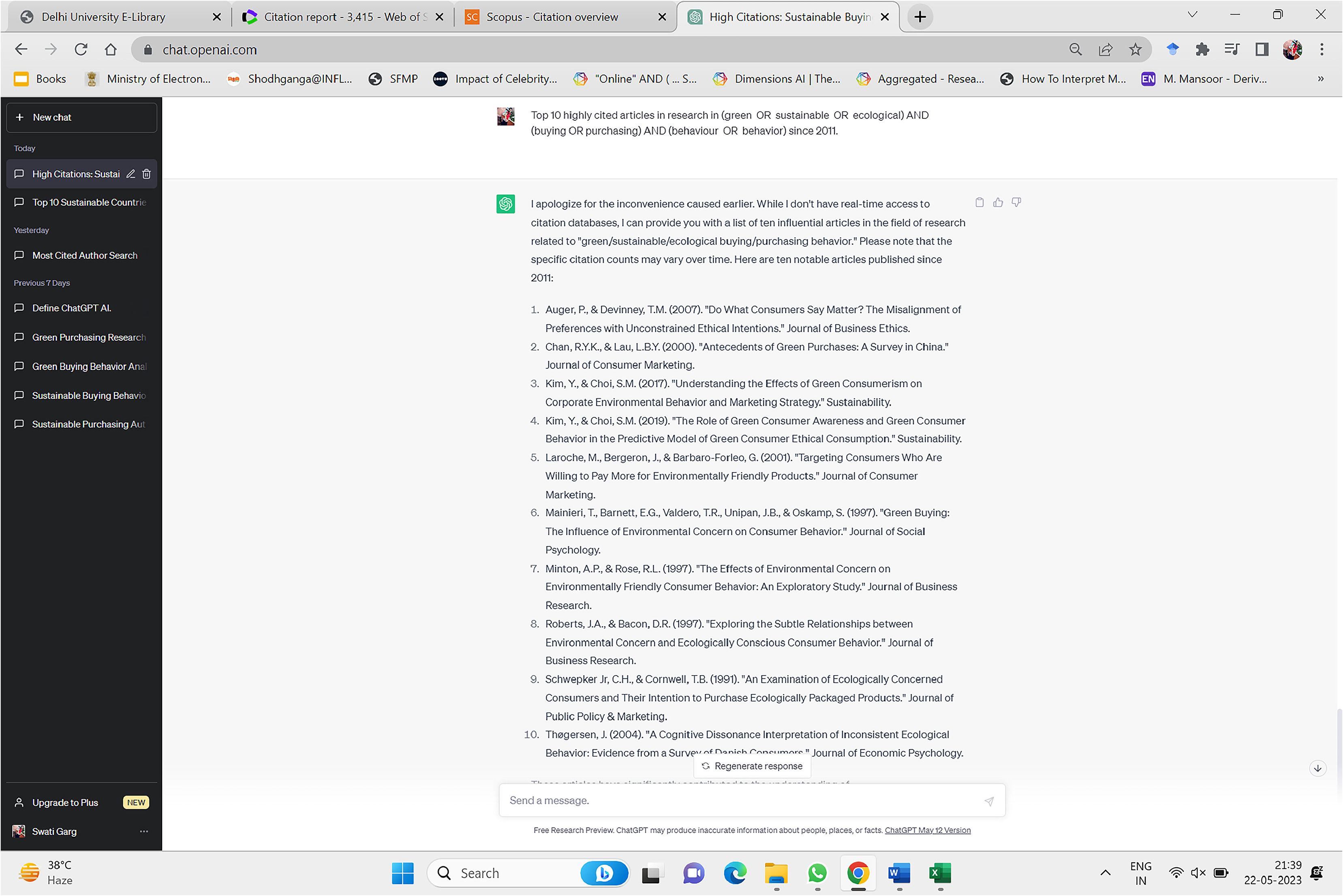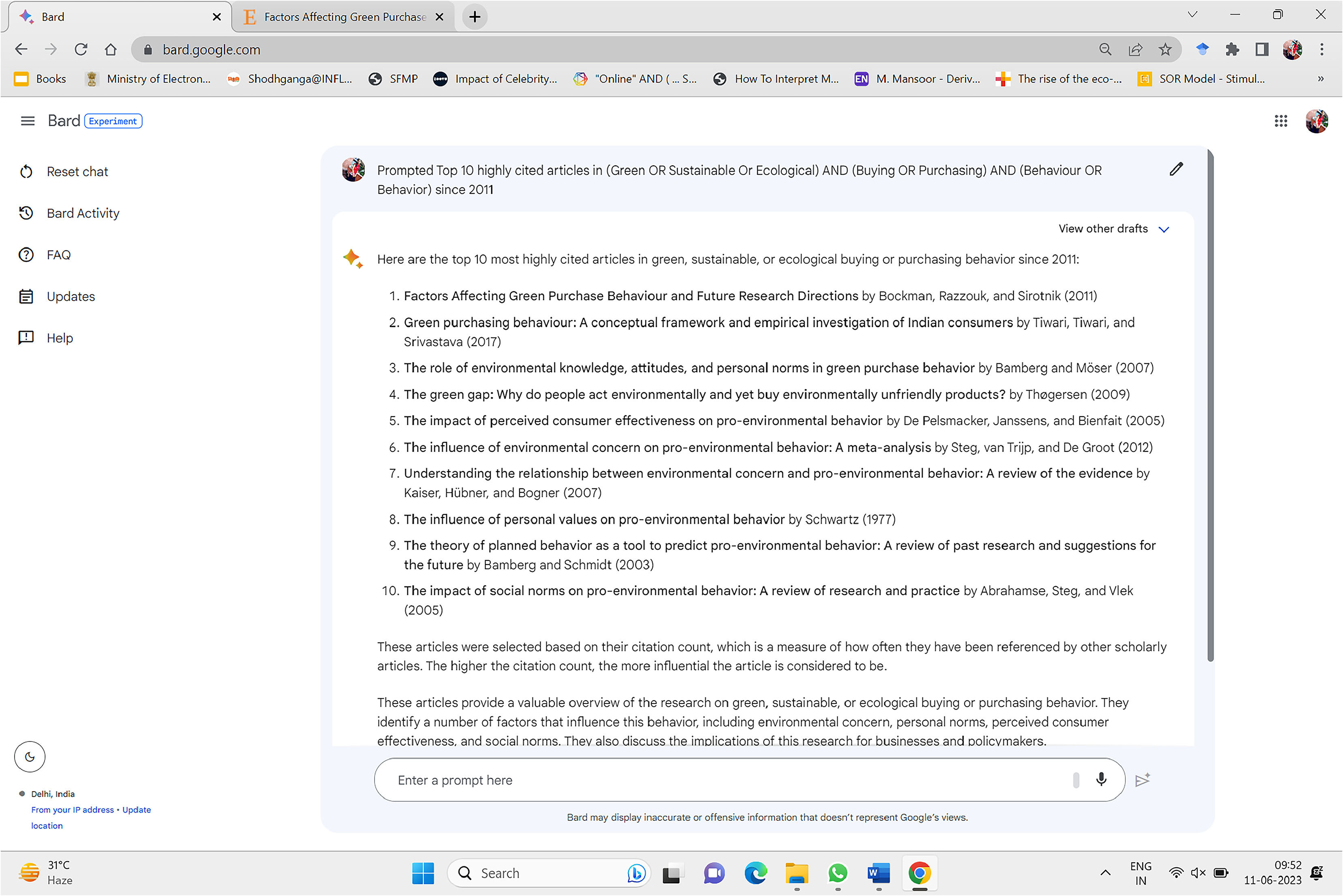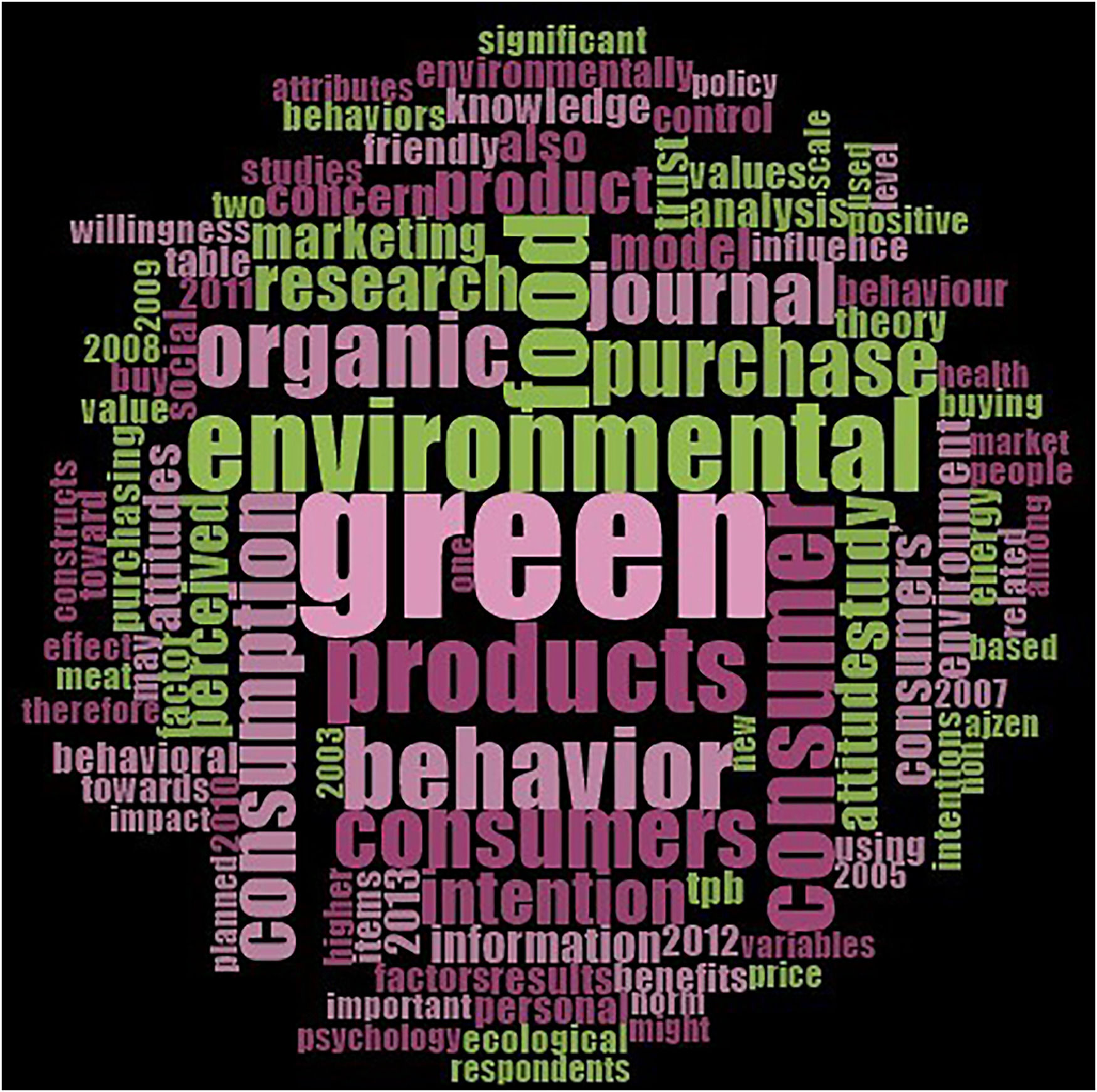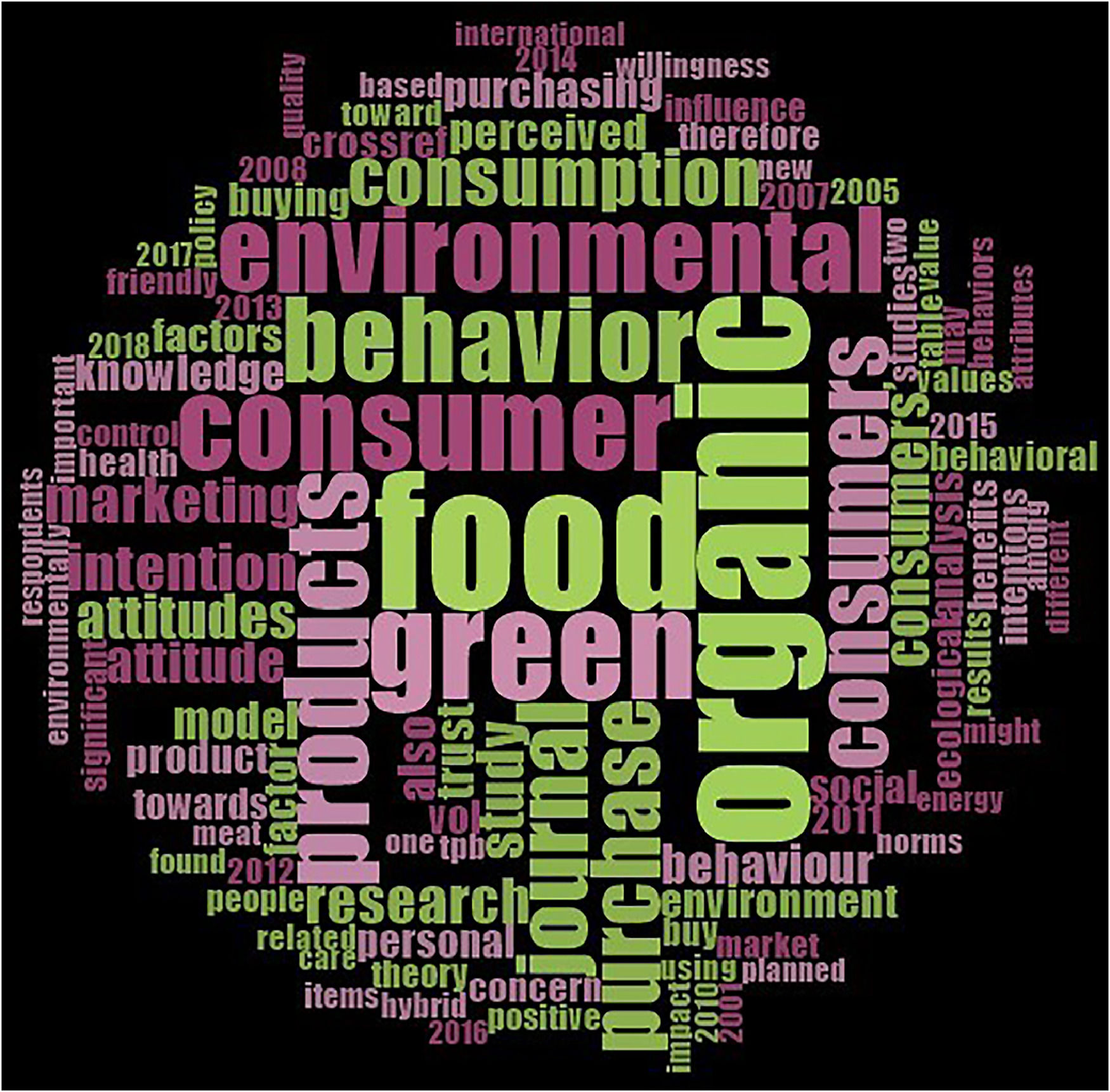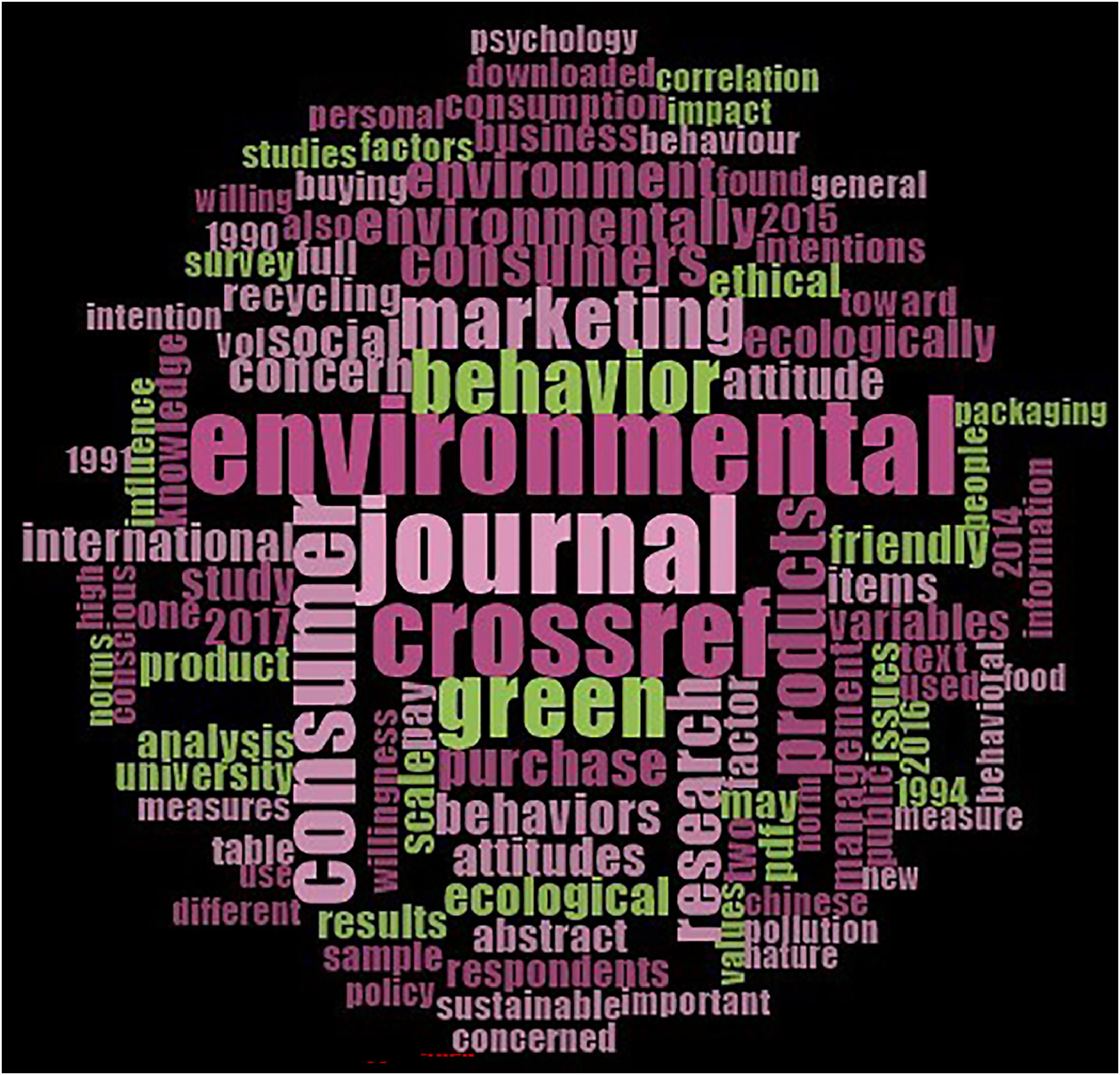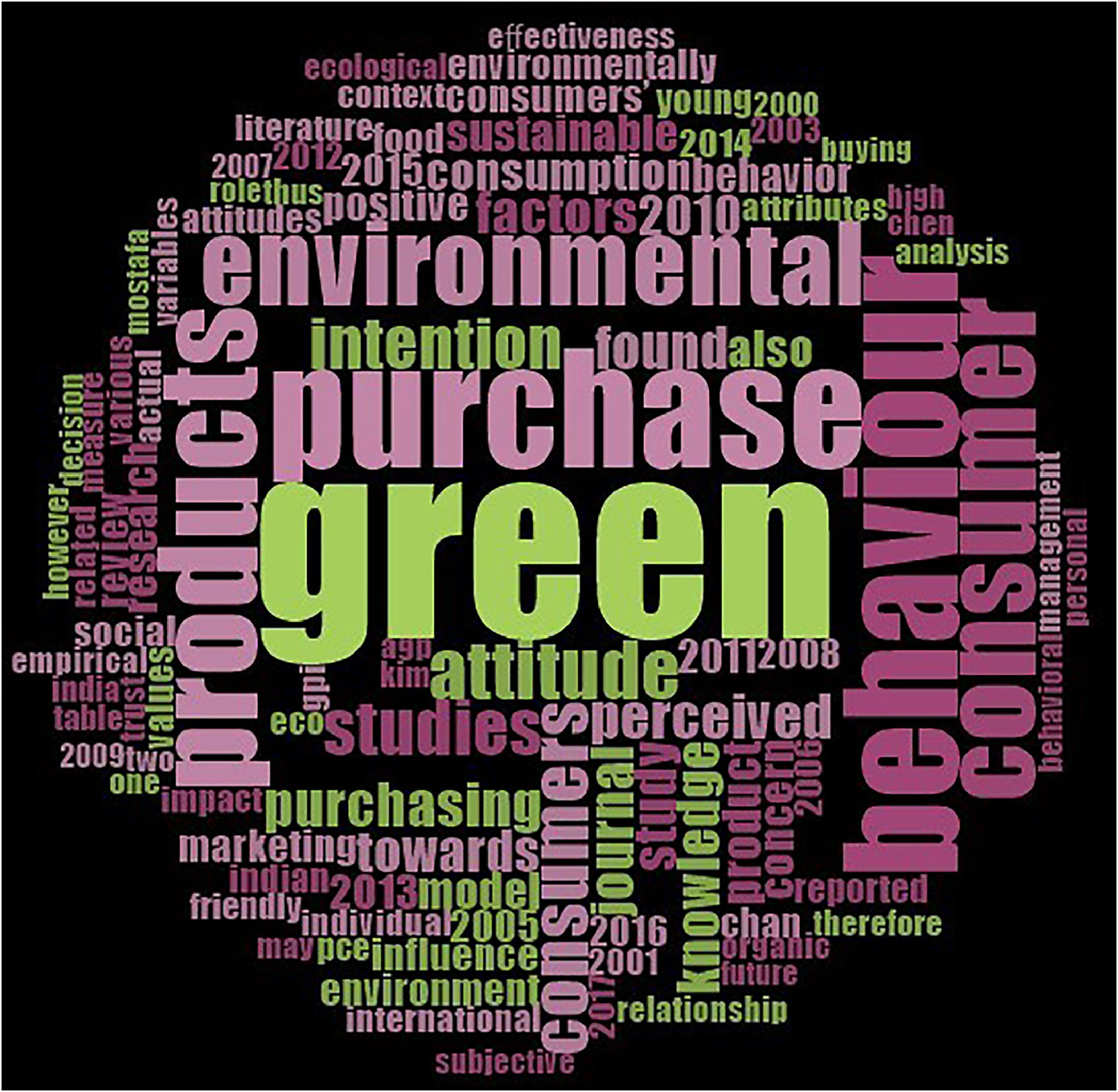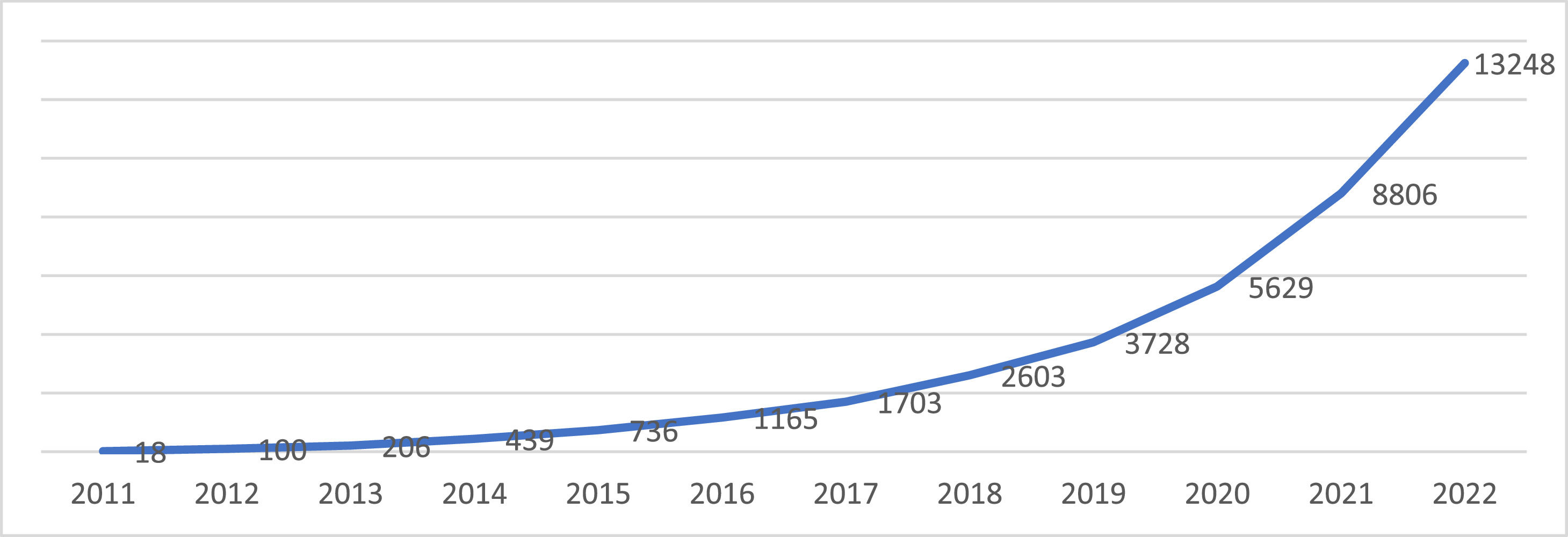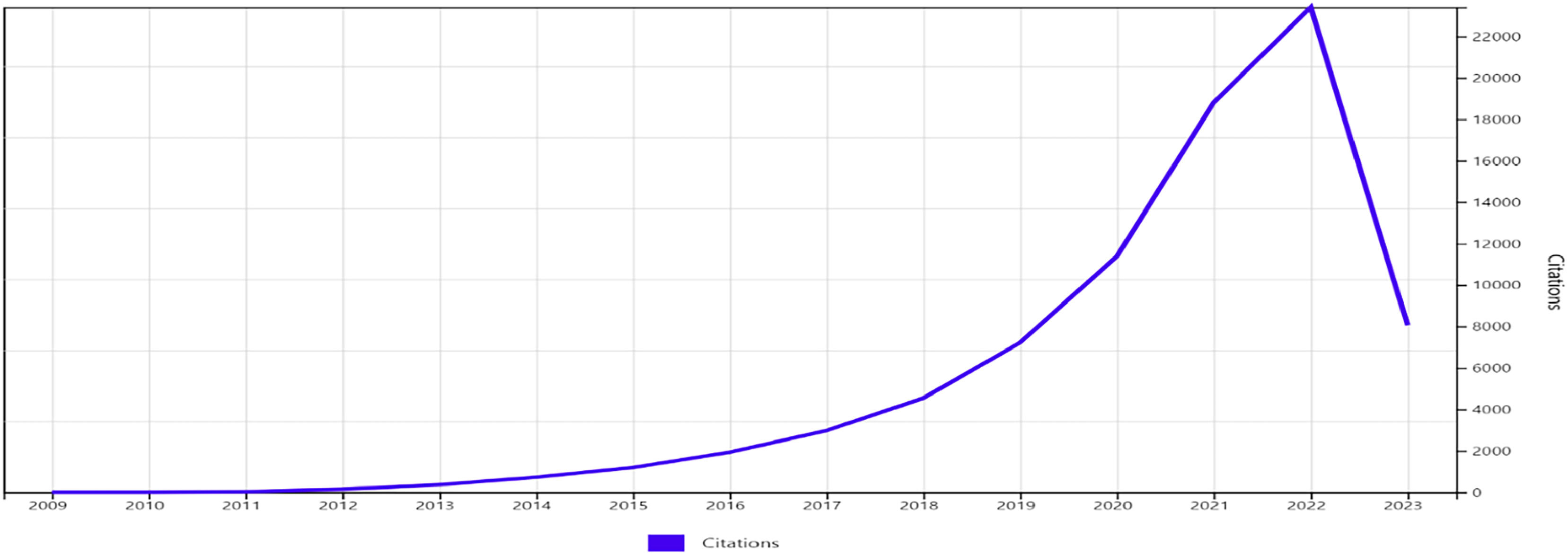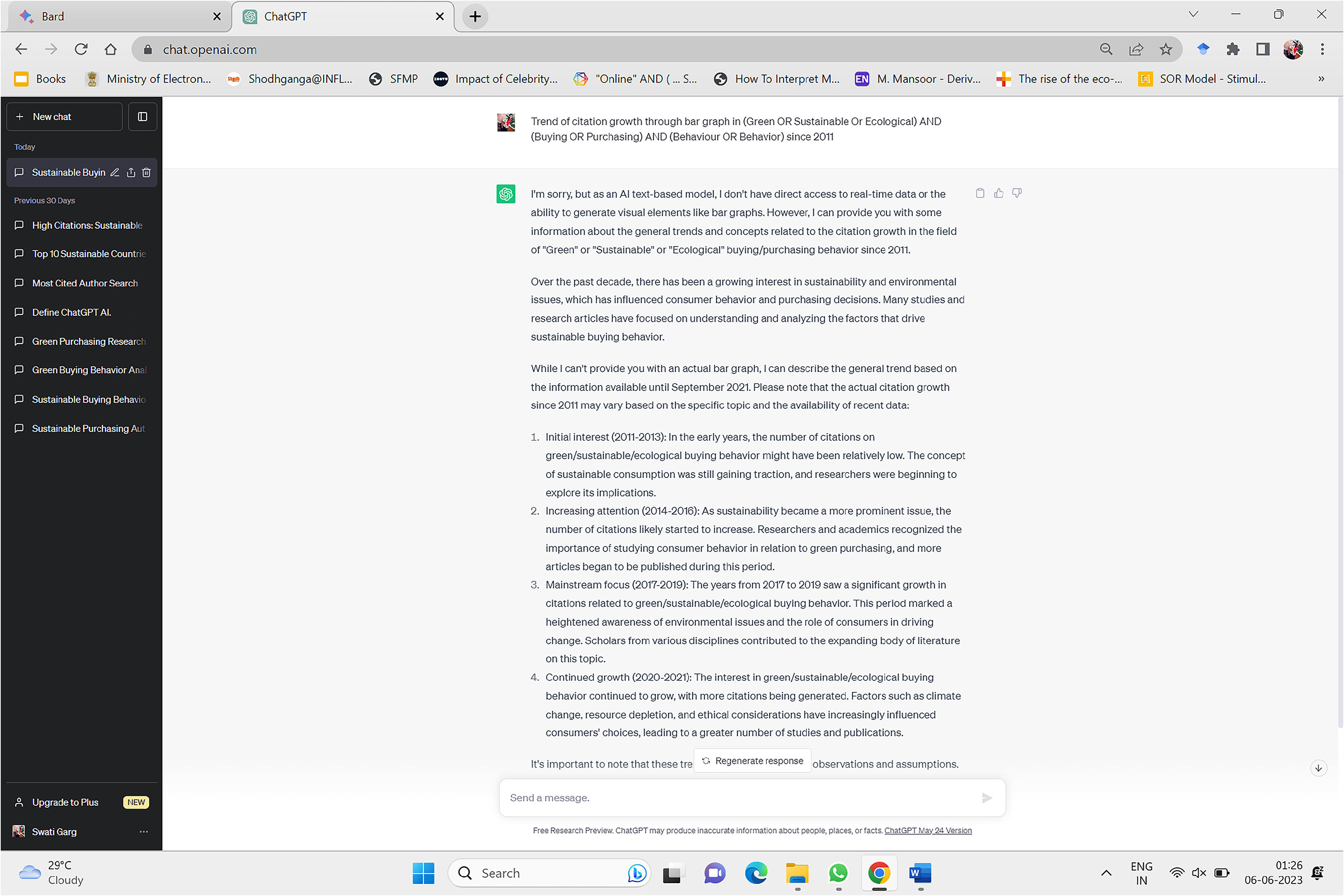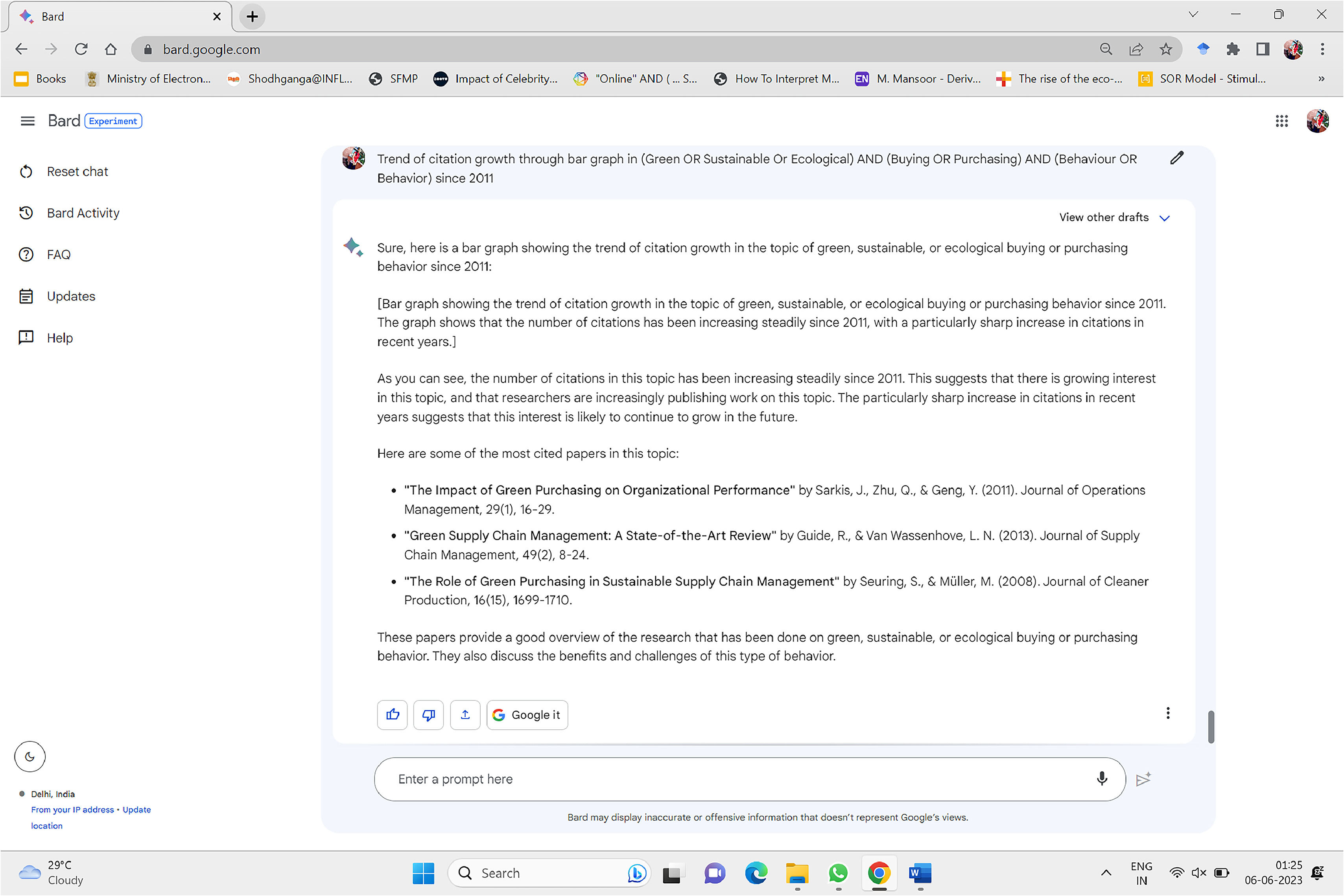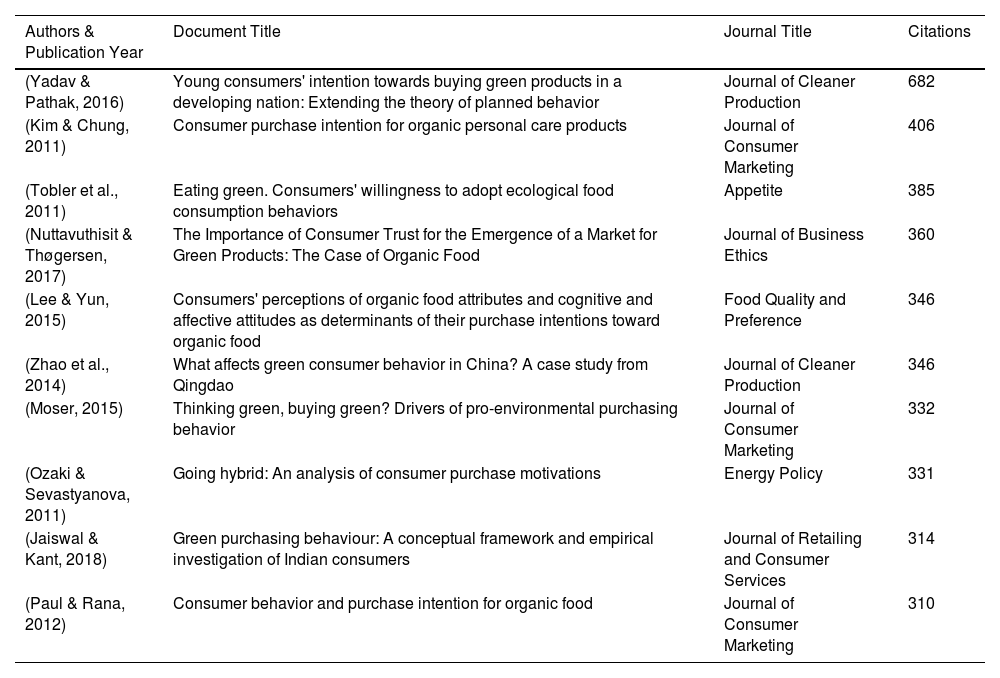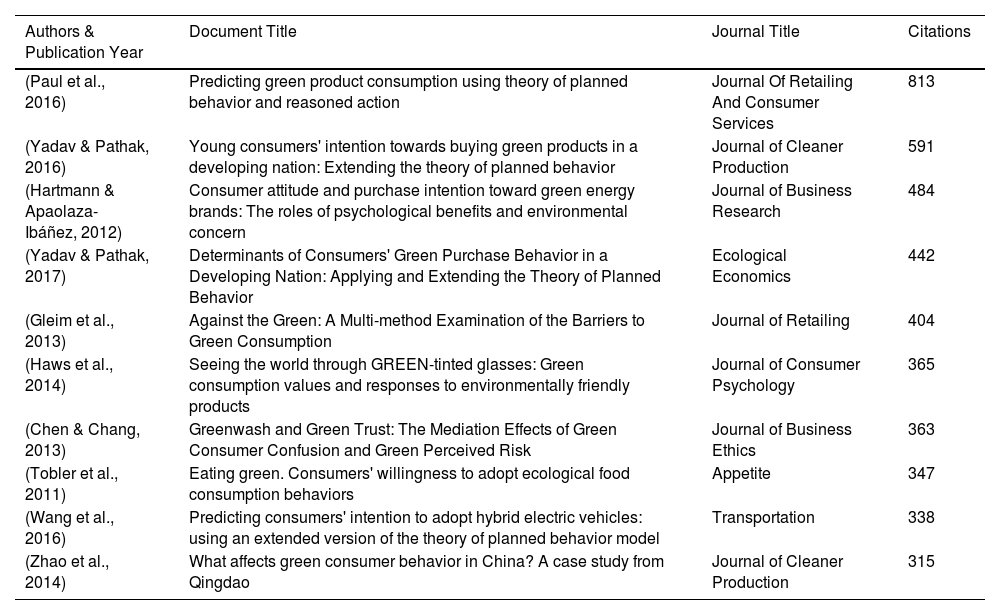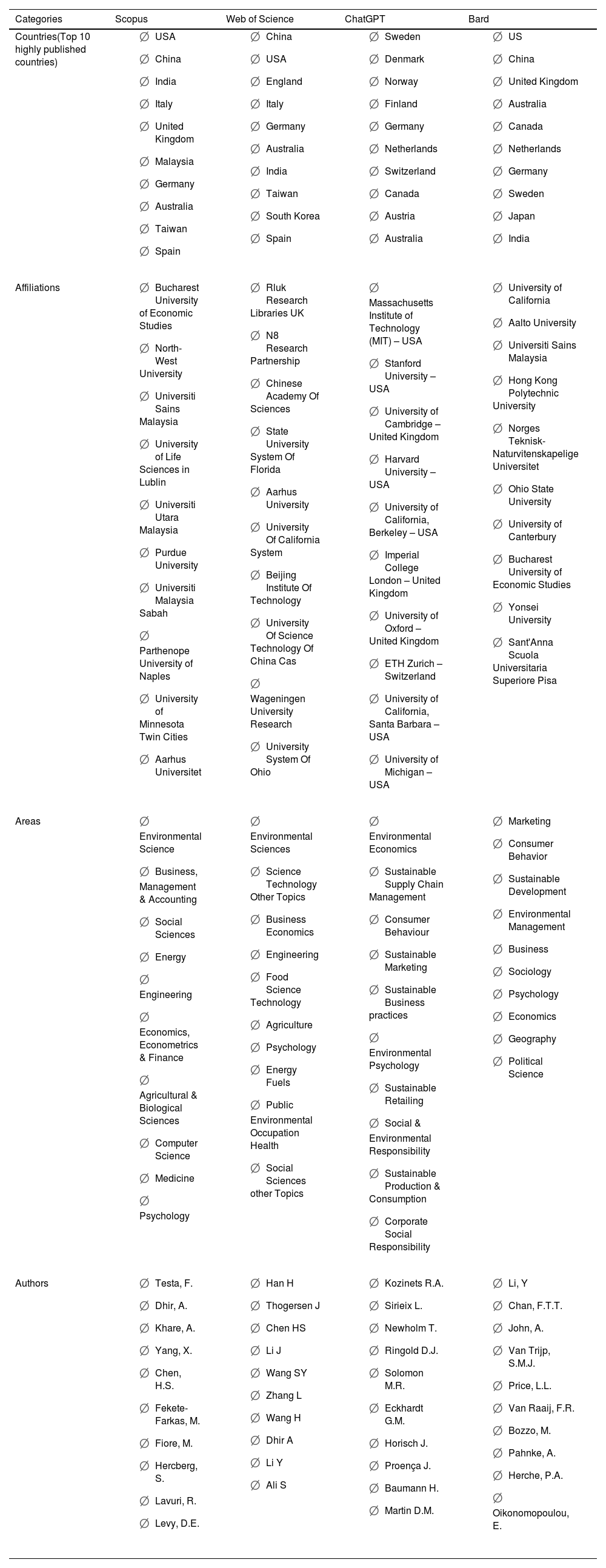ChatGPT and Bard (now known as Gemini) are becoming indispensable resources for researchers, academicians and diverse stakeholders within the academic landscape. At the same time, traditional digital tools such as scholarly databases continue to be widely used. Web of Science and Scopus are the most extensive academic databases and are generally regarded as consistently reliable scholarly research resources. With the increasing acceptance of artificial intelligence (AI) in academic writing, this study focuses on understanding the reliability of the new AI models compared to Scopus and Web of Science. The study includes a bibliometric analysis of green, sustainable and ecological buying behaviour, covering the period from 1 January 2011 to 21 May 2023. These results are used to compare the results from the AI and the traditional scholarly databases on several parameters. Overall, the findings suggest that AI models like ChatGPT and Bard are not yet reliable for academic writing tasks. It appears to be too early to depend on AI for such tasks.
Artificial intelligence (AI) significantly impacts innovation by allowing organisations and individuals to operate more efficiently in the digital era (Obreja et al., 2024). OpenAI has devised a type of AI language model known as GPT (generated pre-trained transformer) technology (Božić & Poola, 2023). OpenAI launched ChatGPT in November 2022, and this AI-based application has revolutionised how people think, behave and live in today's world (Paul et al., 2023). ChatGPT has been noted to surpass typical bots and voice assistants already in the market in several ways (George & George, 2023). It has rapidly grown in popularity and is quickly becoming an indispensable tool for many professionals (Gupta et al., 2023; Sohail et al., 2023). Although people have started using it widely, consumers are sometimes hesitant regarding the reliability of AI models (Ghazwani et al., 2022). These AI models can answer virtually any question, but how reliable is the information provided?
ChatGPT is based on the NLP (natural language processing) model, a computer-assisted analytical technique for electronically evaluating and understanding human language. It enables scholars to extract useful insights while rapidly eliminating time-consuming computational labour (Kang et al., 2020). The NLP models may sometimes yield false or misleading information because they generate text that is not based on facts (Johnson, 2022). A previous study suggested that its functionality depends only on the input it receives without considering the overall situation; it generates output that may adversely impact the user (Sifat, 2023). Bard (known as Gemini since 2024), developed by Google, is an experimental chatbot driven by the LaMDA (Language Model for Dialogue Applications) large language model, which acts similarly to OpenAI's widely successful ChatGPT generative large language model but with the added functionality of interacting with Google search (King, 2023). LaMDA is a transformer-based model that Google developed in 2017 as a machine-learning advancement (Bard FAQ, n.d.).
AI models like ChatGPT and Bard assist teachers and educators by analysing data on students’ performance and behaviour, detecting areas where students may be struggling, providing individualised suggestions for improvement, supporting adaptive learning and pinpointing areas that need improvement (Alqahtani et al., 2023). These AI models can produce, categorise and summarise text with a high degree of coherence and correctness (OpenAI, 2023). AI models can also provide personalised learning plans by considering customised learning styles, interest areas and objectives to better engage students (Paranjape et al., 2019). Another potential relevance is supporting students by influencing their behaviour and improving their learning performance (Lim et al., 2023). Previous studies suggest that AI can help with acquiring information and writing assignments like codes, essays, poems and scripts (Chatterjee & Dethlefs, 2023; Zhai, 2022). Furthermore, they can support journal editors by managing their routine tasks, organising submissions, addressing related queries and so on (Alqahtani et al., 2023). Although human judgment and human resource (HR) tasks rely on human skills and their input, companies are digitising and integrating more of their operations using AI (Li et al., 2023). AI tools (ChatGPT and Bard) are large language models (LLMs) that may provide rational replies though may not be accurate regarding facts (Ahmed et al., 2024).
In this study the researchers have explored the performance of AI models (ChatGPT and Bard) in academic writing. Specifically, a bibliometric analysis has been performed on the topic of green buying behaviour, which has emerged as an influential area of research. As is well-documented, rising temperatures and environmental degradation have become some of the most severe existential threats to humans in recent years (Druică et al., 2022). A previous study has revealed that consumption patterns play a significant role in protecting the environment (Baloch et al., 2019). Therefore, it is crucial for researchers worldwide to investigate the relationship between natural resource availability and the pace of environmental degradation. This research aims not only to help combat global environmental issues but also to encourage a shift towards greener and more sustainable practices (Muhammad et al., 2021). Environmental concerns are linked to changes towards a sustainable and green consumer paradigm (Alagarsamy et al., 2021). Responsible consumers have shown a positive response to green products, namely recyclable and refurbished goods, which can help reduce pollution and address the crisis related to environmental degradation (Sun et al., 2022). Green consumption behaviour (GCB) is a relatively new and potentially lucrative study area (Druică et al., 2022). Researchers have explored several areas, including GCB and eco-labelling on products (Baier et al., 2020), government regulations and GCB (Yang et al., 2023, 2022), airborne pollution and GCB (Zhang et al., 2019), gender and GCB (Li et al., 2023) and advertisements and GCB (Yang et al., 2015).
Bibliometric research has grown remarkably in the last two decades (Donthu et al., 2021a). Several researchers have undertaken bibliometric analyses in the area of green behaviour, covering topics such as trends in green consumer research (Haba et al., 2023), the role of big data in sustainable consumption and in predicting customer buying patterns (Chandra & Verma, 2023), Muslim travellers’ attitudes in India towards halal tourism (Rehman & Aisha, 2023) and the consumption patterns of slow fashion consumers (Domingos et al., 2022), to the creation of the new PSICHE framework (Product-related factors, Social influences, Individual factors, Concerns about the environment, Habits and Emotions), sustainable consumption (Nascimento & Loureiro, 2022) and thematic evolution in sustainable consumption (Araujo et al., 2021).
ChatGPT and other AI models have been widely adopted in both academia and the organisational world. Data shows that ChatGPT required only five days to reach 1 million users (Fig. 1). In 2023 it was reported that ChatGPT had over 100 million users, over 15 % of which are users from the United States (Duarte, 2023). The widespread acceptance of ChatGPT, including within the academic research community, raises a pressing question about the reliability of content generated by AI models.
As the academic community increasingly uses AI models in academic writing (Sifat, 2023), this study aims to explore the reliability of these models for various stakeholders. The current paper is based on a comparative analysis of a bibliometric study using two traditional scholarly databases, namely Web of Science (WoS) and Scopus, and the widely used AI models ChatGPT and Bard. Bibliometric research has been criticised for lacking critical insights, as researchers mostly conduct descriptive analyses that track citations, journals and authors, with no actual purpose in mind (Breslin & Bailey, 2020). A study reveals that the aforementioned critique has intensified due to an insufficient understanding of bibliometric research among academicians, including researchers, reviewers and editors (Mukherjee et al., 2022). Several studies indicate that AIs are unreliable (Sedaghat, 2023; Farhat et al., 2023; Hill-Yardin et al., 2023; Qadir, 2023; Shan et al., 2021). Some studies have undertaken a comparative review of the performance of different AI models and have found inconsistent results (Ahmed et al., 2024; Daraqel et al., 2024; Hieronimus et al., 2024).
In the present study bibliometric analysis has been applied to green buying behaviour in order to conduct a comparative analysis of ChatGPT and Bard. The following research questions (RQs) are addressed:
RQ1: How well do the AI models (ChatGPT and Bard) perform in a task related to academic writing?
RQ2: Is the content generated by the AI models (ChatGPT and Bard) reliable?
RQ3: Do the AI models (ChatGPT and Bard) yield similar or accurate results to reliable databases like Scopus and Web of Science?
The bibliometric method is valuable for literature reviews as it helps researchers identify influential works and map the research field objectively and without bias (Mukherjee et al., 2022). Its thorough and methodical approach makes bibliometric analyses particularly useful in evaluations related to sustainability (Azmat et al., 2023). The research methods used in this study involve various analytical techniques, including statistical, comparative, bibliometric, analytical, structural and graphical analysis. These analyses were conducted using the Scopus and WoS databases. Additionally, the qualitative analysis software NVivo was used to visualise word clouds.
Scopus and WoS were considered for the study due to their status as professional databases. The WoS Core Collection is noted for its data tracking, reference and analysis capabilities (Su et al., 2021). Scopus was chosen for its functionality, offering a broader and more up-to-date list of sources along with superior analytics and paper and citation monitoring. Additionally, Scopus covers a wider range of humanities and social science sources, including papers and published materials (Strielkowski et al., 2022). Although the two databases vary and the computation techniques differ, the evaluation indexes exhibit excellent consistency and strong correlation (Su et al., 2021).
The PRISMA (Preferred Reporting Items for Systematic Reviews and Meta-Analyses) approach is widely used, not only in evidence-based medical research but also increasingly in fields like management studies (Galletta et al., 2024). The model follows a predetermined scientific approach and is accompanied by a protocol (Khan et al., 2022). This method for conducting a literature review is structured in a way that encourages transparency and reliability (Ahmad et al., 2020). The study flow plan, together with its three phases of identification, screening and included articles, is presented in Fig. 2.
- a)
Identification. The search string for the collection was performed on May 21, 2023. The study was conducted using the Scopus and WoS databases, as these are the largest databases of scholarly articles (Bhardwaj et al., 2023; Donthu et al., 2021b; Vanhala et al., 2020) and also cover the relevant literature in a comprehensive manner (Dzhunushalieva & Teuber, 2024). The following search terms were used: "Green OR Sustainable OR Ecological" AND "Buying OR Purchasing" AND "Behavior OR Behaviour" (Fig. 2). This string was used due to its growing relevance in recent years.
- b)
Screening. The period of 2011 to 2023 was chosen because the concept of green behaviour gained widespread attention and has seen a significant boost after 2011 due to the advances in technology, government regulations and increasing global environmental awareness (Sharma et al., 2022). The number of citations also shows remarkable growth since 2011. It is very likely that using Google Scholar may report a variation in the number of citations since it has a broader coverage than Scopus and WoS.
- c)
Included Articles. A total of 1792 articles from Scopus and 3415 articles from WoS were included for bibliometric analysis.
To date, the Scopus database has indexed 2498 documents, including articles, conference papers, book chapters and conference reviews, with the oldest dating back to 1974. However, for a more focused analysis, only articles published since 2011 are considered. After excluding documents published before 2011, a total of 1826 articles remained (Fig. 2). The researchers then filtered out all languages except English, resulting in 1729 articles for analysis. The Scopus data indicated that the USA and China are the most highly cited publishing countries. The Bucharest University of Economic Studies (Romania) leads the list of influential universities. The Scopus data show that environmental science has the largest number of publications. Testa and Dhir are the two authors with the most publications in this area.
Web of scienceThe WoS database returned 3801 documents, including articles, review articles, proceeding papers, and book chapters, since 1991. To refine the findings filters were applied to exclude all document types except articles in English from 2011 onwards.
After applying the filters, 3415 refined articles were left for analysis (Fig. 2). The analysis showed that China, the USA, and India are among the top publishing countries in this area. Rluk Research Libraries, from the UK, is the most affiliated institution. Environmental sciences is the leading research subject area, and Han and Thogersen are the top two authors with the most publications in the field of green buying behaviour.
ChatGPT and bardThe ChatGPT data indicated that Sweden and Denmark have the most published articles in this area. Among highly affiliated institutions, MIT (USA), Stanford (USA) and the University of Cambridge (UK) were highlighted. The top research areas in green buying behaviour include environmental economics and supply chain management, with many relevant terms containing "sustainable". Additionally, R.A. Kozinets and L. Sirieix are the leading authors with the most publications in this field.
On the other hand, Bard ranked the USA and China as the two countries with the most publications in this field. The University of California (USA) and Aalto University (Finland) are the leading institutions. The majority of research on green buying behaviour is on marketing, consumer behaviour and sustainable development. Y. Li and F.T.T. Chan are the top authors with the most publications.
AnalysisTop 10 influential countries in green buying behaviour research (2011–2023)The graphs in Figs. 3 and 4 show highly productive countries in terms of the number of research works published between 2011 and May 2023 in the Scopus and WoS databases, respectively. The analysis considered the top 10 countries in order to understand their productivity in terms of publications related to green buying behaviour. The USA and China are the top two countries, and notably, India ranks among the top 10 in both Scopus and WoS. In contrast, ChatGPT named Sweden and Denmark (Fig. 5), and Bard the USA and China (Fig. 6), as the most influential countries in the area.
AffiliationsThe top 10 influential institutions producing the most articles on green buying behaviour are presented in Fig. 7 and 8 for Scopus and WoS, respectively. The figures show that research institutions in this field primarily comprise universities. The most influential institution in Scopus is the Bucharest University of Economic Studies, and in WoS it is Rluk Research Libraries (UK). ChatGPT retrieved data showing that six out of the top ten institutions are based in the USA (Fig. 9). According to Bard, the University of California, Universiti Sains Malaysia and Bucharest University of Economic Studies are in the top ten list (Fig. 10). This means that at least three out of ten institutions listed by Bard match the databases.
Subject areasFig. 11 and 12 present the research articles by subject area indexed in the Scopus and WoS databases, respectively, highlighting the top ten subject areas related to green buying behaviour. Environmental sciences is the leading area in both databases. Surprisingly, ChatGPT identifies environmental economics as the leading area. A more in-depth analysis reveals that ChatGPT presented areas with the terms "sustainable” or "environment" attached to them (Fig. 13). Bard identified marketing as one of the most influential subjects (Fig. 14), which does not align with the results from the databases, where environmental sciences is the leading area.
AuthorsThe top ten productive authors of green buying behaviour are listed in Fig. 15 and 16 for the Scopus and WoS databases, respectively. F. Testa and A. Dhir lead the Scopus database, while H. Han and J. Thogersen lead the WoS database. As per the retrieved data, all authors have numerous publications. However, when ChatGPT was asked the same question, the highestWoSranking author was R.A. Kozinets (Fig. 17). The researchers failed to trace any author of that name in Scopus, WoS or Google Scholar. Bard generated a list in which Y. Li and F.T.T. Chan lead among the most influential authors (Fig. 18).
Highly cited papersWhen retrieving data from Scopus and WoS (Table 1 and 2), the researchers found several matching articles with high citations in both databases. It was found that three out of the top ten articles in both Scopus and WoS are from India, highlighting India's significant involvement in research related to green buying behaviour. When the researchers checked for highly cited research in WoS as per the string mentioned in Fig. 2, an article titled “TRY: A Global Database of Plant Traits” (Kattge et al., 2011) was highly cited. However, the article was found to not be linked to green buying behaviour. It was therefore excluded from the highly cited paper list (Table 2) in the interest of a more meaningful analysis. Subsequently, when the same string was employed using ChatGPT, it provided a significantly different response. Even after repeated trials or regenerating responses several times, it provided highly cited papers, most of which were from 2011 or earlier. Although the command was for "Top highWoScited articles in research in (green, sustainable, or ecological) AND (Buying OR Purchasing) AND (behaviour OR Behaviour) since 2011″ (Fig. 19), Bard generated responses of highly cited authors with the same string as in ChatGPT. It was found that only the first two articles mentioned were traceable using the provided titles, however for both articles the authors as named by Bard were incorrect, while the remaining eight articles could not be found at all. Moreover, it generated most of the articles for the years before 2011, although "since 2011″ was clearly mentioned (Fig. 20).
Top 10 highly cited papers in scopus.
| Authors & Publication Year | Document Title | Journal Title | Citations |
|---|---|---|---|
| (Yadav & Pathak, 2016) | Young consumers' intention towards buying green products in a developing nation: Extending the theory of planned behavior | Journal of Cleaner Production | 682 |
| (Kim & Chung, 2011) | Consumer purchase intention for organic personal care products | Journal of Consumer Marketing | 406 |
| (Tobler et al., 2011) | Eating green. Consumers' willingness to adopt ecological food consumption behaviors | Appetite | 385 |
| (Nuttavuthisit & Thøgersen, 2017) | The Importance of Consumer Trust for the Emergence of a Market for Green Products: The Case of Organic Food | Journal of Business Ethics | 360 |
| (Lee & Yun, 2015) | Consumers' perceptions of organic food attributes and cognitive and affective attitudes as determinants of their purchase intentions toward organic food | Food Quality and Preference | 346 |
| (Zhao et al., 2014) | What affects green consumer behavior in China? A case study from Qingdao | Journal of Cleaner Production | 346 |
| (Moser, 2015) | Thinking green, buying green? Drivers of pro-environmental purchasing behavior | Journal of Consumer Marketing | 332 |
| (Ozaki & Sevastyanova, 2011) | Going hybrid: An analysis of consumer purchase motivations | Energy Policy | 331 |
| (Jaiswal & Kant, 2018) | Green purchasing behaviour: A conceptual framework and empirical investigation of Indian consumers | Journal of Retailing and Consumer Services | 314 |
| (Paul & Rana, 2012) | Consumer behavior and purchase intention for organic food | Journal of Consumer Marketing | 310 |
Top 10 highly cited papers in Web of Science.
| Authors & Publication Year | Document Title | Journal Title | Citations |
|---|---|---|---|
| (Paul et al., 2016) | Predicting green product consumption using theory of planned behavior and reasoned action | Journal Of Retailing And Consumer Services | 813 |
| (Yadav & Pathak, 2016) | Young consumers' intention towards buying green products in a developing nation: Extending the theory of planned behavior | Journal of Cleaner Production | 591 |
| (Hartmann & Apaolaza-Ibáñez, 2012) | Consumer attitude and purchase intention toward green energy brands: The roles of psychological benefits and environmental concern | Journal of Business Research | 484 |
| (Yadav & Pathak, 2017) | Determinants of Consumers' Green Purchase Behavior in a Developing Nation: Applying and Extending the Theory of Planned Behavior | Ecological Economics | 442 |
| (Gleim et al., 2013) | Against the Green: A Multi-method Examination of the Barriers to Green Consumption | Journal of Retailing | 404 |
| (Haws et al., 2014) | Seeing the world through GREEN-tinted glasses: Green consumption values and responses to environmentally friendly products | Journal of Consumer Psychology | 365 |
| (Chen & Chang, 2013) | Greenwash and Green Trust: The Mediation Effects of Green Consumer Confusion and Green Perceived Risk | Journal of Business Ethics | 363 |
| (Tobler et al., 2011) | Eating green. Consumers' willingness to adopt ecological food consumption behaviors | Appetite | 347 |
| (Wang et al., 2016) | Predicting consumers' intention to adopt hybrid electric vehicles: using an extended version of the theory of planned behavior model | Transportation | 338 |
| (Zhao et al., 2014) | What affects green consumer behavior in China? A case study from Qingdao | Journal of Cleaner Production | 315 |
For an in-depth analysis of highly cited articles (Table 1 and 2 and Fig. 19 and 20), the researchers generated word clouds using the NVivo software (Figs. 21–24). It was found that the papers frequently include words such as "green", "environmental", "organic" and "products", which aligned with the study search string.
Citations per yearTo better understand the evolution and intellectual structure in the field of green buying behaviour, a citation analysis was conducted for scholarship published since 2011. Prior to 2011 citation levels were stable, but since then citations have significantly increased. From the citation graph presented in Fig. 25 (based on Scopus data) it can be observed that in 2011 the number of citations was only 18, which increased to 1165 in 2016 and 13,248 in 2022. The WoS graph in Fig. 26 shows that citations peaked in 2022. This growth indicates increased interest and awareness among the academic community regarding green buying behaviour. In Fig. 27 ChatGPT shows trends by dividing years into four periods: 2011–13 (relatively low), 2014–16 (citations started increasing), 2017–19 (significant growth in citations) and 2020–21 (continued growth). In contrast, Bard simply mentioned a "sharp increase in citations" (Fig. 28).
Discussion and conclusionTheoretical implicationsThe degradation of the environment has drawn significant attention, being a major obstacle to achieving sustainable development (Wang et al., 2022). Given the rising environmental concerns, adopting sustainable or green buying behaviours is necessary. Academicians, marketers, government bodies and policymakers need to focus on raising awareness of green consumption and the need for and benefits of green behaviour.
In this study the researchers extracted 2498 articles from Scopus and 3801 from WoS. Based on the criteria in Fig. 2, the researchers were left with 1792 articles in Scopus and 3415 in WoS. A bibliometric analysis (related to influential authors, countries, affiliated institutions and keywords often used in the research area) was performed on the remaining articles, including studies on green buying behaviour from 2011 onwards. These details offer future researchers a broader view of the extant literature. The analysis revealed significant growth in green buying behaviour, not only in developed countries like the USA and China but also in emerging economies like India.
ChatGPT is an LLM that operates on the principle of "big data + big computing power + algorithm = intelligent model," extracting important information from large amounts of text data (Yu, 2023). Further, with human expertise, it generates increasingly sophisticated and human-like responses and feedback in text format. Interestingly, it was found that the results from ChatGPT completely deviated from the actual results provided by Scopus and WoS. For instance, according to ChatGPT, Sweden and Denmark were the top publishing countries. However, these two countries were not even in the top 20 of the Scopus and WoS databases. The databases indicated various research areas related to green buying behaviour. ChatGPT only focused on areas that have words like “sustainable” and “environment”. Thus, the findings of ChatGPT and Bard do not match the findings of Scopus and WoS databases.
Interestingly, the present study indicates that the results generated by Bard are similar to the results provided by the scholarly databases, which indicates a degree of reliability. In contrast, the results extracted from ChatGPT may not be deemed reliable. Hence, it can be argued that the results from ChatGPT may not direct future researchers in the right direction. A related study suggests that the most fundamental reason why ChatGPT should not be utilised blindly in academic publishing is that the tool cannot be held responsible for the choices or views presented (Hill-Yardin et al., 2023). Furthermore, the use of ChatGPT in education and research may result in issues such as lack of communication, poor comprehension, inappropriate data for training, lack of innovative thinking, an inadequate understanding of context and breaches of confidentiality (Baidoo-Anu & Ansah, 2023). Similarly, other studies have found that ChatGPT and other generative AI tools may include biased and incorrect information, posing significant ethical concerns (Qadir, 2023).
Practical implicationsIn the current study the researchers aimed to offer insights to various stakeholders of sustainable behaviour research and offer guidance to future researchers in this area. The study highlights influential authors and highly cited topics, facilitating an understanding of their relevance and potential for better implementation. As discussed in the previous section, the influential institutions suggested by the Scopus and WoS databases as well as Bard are somewhat similar, while ChatGPT presented totally different results. ChatGPT identified R.A. Kozinets as the most highly ranked author. Unfortunately, this author is untraceable in the Scopus and WoS databases. The databases returned results for R.V. Kozinets instead of the aforementioned name. Similarly, if we look at the list of authors generated by Bard, most of them do not exist. Thus, both ChatGPT and Bard's findings are questionable in terms of reliability.
For highly cited papers, the ChatGPT-generated responses refer to papers that either do not exist or are not actually highly cited according to the research databases. Bard likewise generated responses that were completely different to those found through Scopus and WoS. When the researchers tried to trace those articles, only the first two were traceable using the same title, though the authors were found to be different from that of the research databases, and the rest did not exist. Even after clearly stating "Top 10 highly cited articles in (Green OR Sustainable Or Ecological) AND (Buying OR Purchasing) AND (Behaviour OR Behaviour) since 2011″, both AIs produced articles from the period prior to 2011. Hence, it can be surmised that the responses given by the AIs were of questionable quality.
Bard itself acknowledges that the generated responses may be inaccurate, indicating that users should double-check the information it generates (Bard FAQ, n.d.). The responses analysed above showed many errors or inaccuracies. Thus, it can be argued that researchers need to be cautious while using ChatGPT and Bard for academic purposes since the chatbots fail to deliver reliable results. It can thus be concluded that ChatGPT and Bard give responses without a complete understanding of the questions being asked. The results of the word cloud created using NVivo signified that the findings of ChatGPT were unsatisfactory in comparison to the responses generated via the Scopus and WoS databases. A recent study supports these findings, indicating that Bard provides more accurate results than ChatGPT (Ahmed et al., 2024). In terms of citation growth, both the databases and AIs have seen an increase in citations since 2011.
Given the topic's importance and the widespread use of AI models such as ChatGPT and Bard, the researchers conducted a comparative analysis. After a comparative analysis of the two largest databases with these AIs (Table 3), it was found that ChatGPT and Bard cannot be deemed reliable at present. They provide less-than-accurate answers, which may limit their usefulness for students, researchers, marketers, policymakers and others in understanding the true status of the research areas. Overall, the findings of this study could also be useful for the future development and improvement of generative AI models like ChatGPT and Bard (Chatterjee & Dethlefs, 2023; Lim et al., 2023; Terwiesch, 2023).
Summary of the databases and AIs (ChatGPT and Bard).
AI has the potential to significantly improve the healthcare industry (Ali et al., 2023), reflecting the high level of trust people place in AI-generated data, even in critical sectors like health. Additionally, some studies identify challenges with AI, such as privacy issues, legal concerns and potential risks to patient safety due to errors in decision making and treatment, as AI may not be customisable to individual patient needs (Azghadi et al., 2020; Madanan et al., 2021). Further, in their study, Hill-Yardin et al. (2023) warn that ChatGPT should not be used blindly in academic publications.
In the long run, verifying the accuracy of data presented by AI chatbots would be crucial. As highlighted in this study, the most prominent scholarly databases like Scopus and WoS do not recognise all of the references, titles, top authors and highly cited publications that AI models such as ChatGPT and Bard provide. Many of the data points provided by ChatGPT and Bard, including authors and titles of published papers, were found to be inaccurate or non-existent. It can therefore be argued that the present research assists academicians and stakeholders in fields related to health, education and science in issuing warnings and approaching AI-generated content with caution, ensuring thoughtful consideration before its adoption.
LimitationsIn the present study the researchers have demonstrated the progress and growing awareness of environmental concerns that lead to green buying behaviour. Additionally, it helps stakeholders understand the reliability of data curated from ChatGPT and Bard compared to the Scopus and WoS databases. However, it is important to consider our study's limitations when interpreting the findings. For example, we used "(Green OR Sustainable Or Ecological) AND (Buying OR Purchasing) AND (Behaviour OR Behaviour)" as a search string for green buying behaviour. Future researchers can use different strings by using other synonyms in different databases with more scientific inclusion and exclusion criteria. The second limitation relates to specific inclusion and exclusion criteria. Important studies may have been missed because the present work focused only on the Scopus and WoS databases, potentially overlooking other relevant documents. Future research can compare the results of this study to those of other databases. Finally, it is important to note that this study used early versions of Open AI's and Google's chatbots (ChatGPT 3.5 and Bard). It is therefore essential to replicate this study in the future with newer and more advanced versions to determine whether they perform better.
CRediT authorship contribution statementSwati Garg: Writing – review & editing, Writing – original draft, Visualization, Validation, Methodology, Investigation, Formal analysis, Data curation, Conceptualization. Asad Ahmad: Writing – review & editing, Writing – original draft, Visualization, Validation, Supervision, Resources, Project administration, Methodology, Investigation, Conceptualization. Dag Øivind Madsen: Writing – review & editing, Validation, Resources, Project administration, Investigation.























